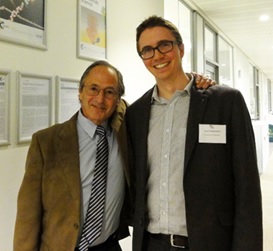Professor Michael Levitt
DOI:
https://doi.org/10.31273/eirj.v3i1.122Keywords:
Michael Levitt, 2013 Nobel Prize in Chemistry, Role Models, InterdisciplinarityAbstract
Professor Michael Levitt (Stanford University, USA) won the 2013 Nobel Prize in Chemistry for the development of multiscale models for complex chemical systems—computational tools which can calculate the course of chemical reactions. Professor Levitt was born in Pretoria, South Africa; he came to the UK on a summer vacation aged 16, where he decided to stay and study for his A‑levels. His interest in the physics of living systems drove him to study biophysics at King’s College London, before securing a PhD position at the Laboratory of Molecular Biology in Cambridge. In the interim year between his degree and beginning his PhD, Professor Levitt worked at the Weizmann Institute of Science in Israel, where he met his future wife. They married later that year and moved to Cambridge, where their three children were born. After completing his PhD, he spent time working in Israel, Cambridge, the Salk Institute and Stanford (both California). Since 1986, he has split his time between Israel and California. Outside of science, he is a keen hiker and he is well-known to have attended the eclectic ‘Burning Man’ Festival in California.[1]
Professor Levitt visited the University of Warwick to speak at the Computational Molecular Science Annual Conference in March 2015. In this interview, Dr Gemma-Louise Davies, an Institute of Advanced Study Global Research Fellow, spoke to Professor Levitt about the importance of Interdisciplinarity in his field, role models in Academia, and his plans for the future.
Image: Professor Michael Levitt (left) with Dr Scott Habershon (right, organiser of the 2015 Computational Molecular Science Annual Conference) during his visit to the University of Warwick in March 2015.
[1] ‘Burning Man’ is a unique annual festival dedicated to community, art, music, self-expression and self-reliance. Tens of thousands of people flock to this temporary metropolis built in the Californian desert.
Downloads
References
Editorial (2015), ‘Mind Meld’. Nature, 525, 289–90.
Ledford, H. (2015), ‘How to solve the world's biggest problems’, Nature, 525, 308–11.
Levitt, M. (1975), ‘Computer simulation of protein folding’, Nature, 253, 694–98.
Rylance, R. (2015), ‘Grant giving: Global funders to focus on interdisciplinarity’, Nature, 525, 313–15.
Van Noorden, R. (2015), ‘Interdisciplinary research by the numbers’, Nature, 525, 306–07.
Wagner, C. S., Roessner, J. D., Bobb, K., Klein, J. T., Boyack, K.W., Ketyton, J., et al. (2011), ‘Approaches to understanding and measuring interdisciplinary scientific research (IDR): A review of the literature’, Journal of Informetrics, 5 (1), 14–26.
Warshel, A., Levitt, M. (1976), ‘Theoretical studies of enzymatic reactions: dielectric, electrostatic and steric stabilisation of the carbonium ion in the reaction of lysozyme’, Journal of Molecular Biology, 1976, 103 (2), 227–49.

Published
Issue
Section
License
Authors who publish with this journal agree to the following terms:
Authors retain copyright and grant the journal right of first publication with the work simultaneously licensed under a Creative Commons Attribution License (CC-BY), which permits use and redistribution of the work provided that the original author and source are credited, a link to the license is included, and an indication of changes which were made. Third-party users may not apply legal terms or technological measures to the published article which legally restrict others from doing anything the license permits.
If accepted for publication authors’ work will be made open access and distributed under a Creative Commons Attribution (CC-BY) license unless previously agreed with Exchanges’ Editor-in-Chief prior to submission.
Authors are able to enter into separate, additional contractual arrangements for the non-exclusive distribution of the journal's published version of the work (e.g., post it to an institutional repository or publish it in a book), with an acknowledgement of its initial publication in this journal.
Authors are permitted and encouraged to post their work online (e.g., in institutional repositories or on their website) prior to and during the submission process, as it can lead to productive exchanges, as well as earlier and greater citation of published work. (see: The Effect of Open Access)
